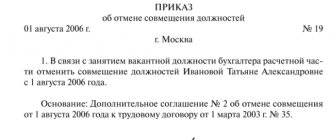Qualification Handbook
To determine the classification of positions and instructions, there is a special unified qualification directory. Abbreviated as ETKS, approved on the basis of a decree of the government of the Russian Federation. Thanks to him, enterprises formulate personnel activities. According to the content of Article 143 of the Labor Code of the Russian Federation, qualifications of professions and duties are carried out on the basis of a unified tariff and qualification reference book.
It consists of two chapters: the first characterizes the industry management workforce, the second - the envisaged professions of the enterprise's main employees and blue-collar specialties.
Why do you need a schedule?
The staffing table has these functions:
- Accurate and quick establishment of the organizational structure of the company.
- Fixing the number of departments and the number of staff units for each position.
- Convenient establishment of a payment system for department employees.
- Fixation of the volume of bonuses for labor.
With the help of a staffing table, it is easier to monitor vacancies and select applicants for vacant positions.
How to reflect vacancies in the staffing table ?
Management team
This list includes the following professions:
- Ch. specialist of the agronomic service (agronomist) of the enterprise.
- Ch. agronomist-agrochemist in production.
- Ch. Agricultural service specialist (agronomist) in the field of crop protection.
- Ch. agronomic service specialist (soil study agronomist).
- Ch. Veterinary service specialist (veterinarian).
- Ch. zootechnical service specialist (zootechnician).
- Ch. specialist of zootechnical service in the horse breeding industry (zootechnician of the state stables).
- Ch. zootechnical service specialist - hippodrome livestock specialist.
- Ch. land reclamation engineer.
- Ch. mechanical engineer.
- Ch. energy specialist (energy engineer).
- Ch. judge in the field of horse breeding.
- Veterinary service worker - head. veterinary pharmacy.
- Veterinary service worker - head. veterinary site
- Head at the enterprise garage.
- Head procurement point at the processing plant of flax and other bast crops.
- Head toxicology laboratory.
- Head production laboratory of biomethods of plant protection.
- Head laboratory of the state inspection for plant quarantine and fumigation squad.
- Head laboratory for diagnosing and forecasting the future occurrence of pests and plant diseases.
- Head laboratory for assessing the quality of tested varieties of the State Commission for Sorting of Agricultural Crops.
- Head laboratory for breeding business and artificial insemination method.
- Head transport department.
- Head oil depot.
- Head experimental field.
- Head border point for plant quarantine.
- Head point of the artificial insemination method.
- Head point for signaling and forecasting the appearance of pests and plant diseases.
- Head repair shop.
- Head seed station.
- Head of technical exchange office.
- Head variety testing site.
- Head phytohelminthological production laboratory.
- Head seed storage.
- Head of fur. squad.
- Head of the procurement department.
- Head of the department (site) of production and veterinary control.
- Head of technical department operation of the vehicle fleet and equipment of agricultural enterprises.
- Head of the production department of the hippodrome.
- Head of the plant protection station (at the subject, region and district level).
- Head of technical station fleet maintenance, technical stations. maintenance of machine-building park.
- Head of the livestock department.
- Head of the fumigation department.
- Head of technical station maintenance of machinery and equipment for livestock farms, poultry farms and farms.
- Head of the feed production workshop.
- Head of the land reclamation workshop.
- Head of the incubation department.
- Head of the mechanization department.
- Head of the plant growing department.
- Head of the plant bioprotection expedition.
- Head of the transport management department.
- Farm manager, foreman.
- Head of a peasant farmer.
Chief engineer's work
Chief engineer is a position that is found in organizations that produce products and maintain their own fleet of vehicles or a fleet of specialized equipment: agricultural organizations, factories, factories, transport companies, and so on. The job of a chief engineer requires higher technical education in the organization's field of activity. It is on him that the technical equipment of the enterprise with spare parts, fuels and lubricants, the necessary equipment and machines, and the well-coordinated work of mechanics and maintenance personnel depend. With his proposal, all technical units and their spare parts are purchased, and people who service all these machines and devices are hired. Working as a technical director has similar functionality. In some organizations these are identical concepts.
Areas of economic activity where employees are recognized as hazardous occupations
Here is a partial list of such professions:
- Persons whose activities involve gunpowder, ammunition equipment, and initiating and explosive substances.
- Workers in the oil industry, coal mines, etc.
- The activities of which are related to metal processing.
- Employed in electrical production and maintenance of such equipment.
- Manufacturers of radio equipment, production of building materials.
- Production of glass and porcelain.
- Manufacturers and processors of synthetic and artificial fiber, workforce of pulp and paper industry enterprises.
- Employees of institutes and research centers in the field of manufacturing drugs and biomaterials.
- Workforce in the field of healthcare, printing workers, transport workers.
- Those whose activities involve radiation and exposure, nuclear industry workers.
- Divers.
- Welding workers.
- Research activities related to microorganisms.
- Metal testing.
- Cleaning metal with sand.
- Workers of mercury substations.
- Workers of electric trains and stations.
- Labor composition of the food industry.
- Working in the field of film copying.
- Workers in the field of construction, repair and restoration.
- Communication workers.
- Workers in the agrochemical industry.
- Mining industry workers.
- Workers in the chemical and paint industries.
How are personnel distributed by category?
Distribution of personnel by category
External factors influencing the development of production, including the production of products in demand by society include:
- Indicator of the working-age population.
- Literacy level of workers and employees.
- In what area of employment the work is performed.
- Correct distribution of production forces.
Equally important when assessing characterizing parameters is the quantity and quality of manufactured commercial products.
Personnel are divided into the following categories:
- Labor resources. This includes the population that is capable of performing production tasks, while having a certain age and education. These are citizens directly performing labor functions, as well as potential employees.
- Other employees. These are employees with work experience and level of professional training, whose activities are carried out under a temporary employment agreement.
Business entities are capable of solving problems that do not correspond to their main purpose. Therefore, difficulties arise in determining the importance of those working in auxiliary production.
In total, two subgroups are distinguished, namely:
- those engaged in performing important tasks of the production process or directly servicing technological equipment;
- support workers performing the function of servicing the first subgroup of workers.
When calculating earnings, these points must be taken into account.
Mechanical Engineering Professions
If you make a list of working professions in mechanical engineering, there is a division into management, specialists and blue-collar professions. Let's take a closer look.
For example, managers are included in the list of working professions of the management team (head of the design department, head of the testing department, head of product sales, etc.).
If we talk about specialists in mechanical engineering, then these are mechanical engineering technologists, mechanical engineers, designers, etc.
Also involved in mechanical engineering are professions that are classified as common in all sectors of the economy.
What categories of personnel are there?
Classification of personnel by category
There are two categories of workers: workers and employees. The second category includes:
- administrative staff;
- managers;
- engineers;
- personnel officers.
In the personnel division classifier, there are only two categories of professions, these include:
- Workers. These workers are engaged in direct production. They are engaged in the production of products in which this enterprise specializes. Moreover, they must maintain production areas in proper condition.
- Employees. These include workers who are not directly involved in the production of products, but their activities are indirectly or directly related to production. They can perform tasks that address important technology issues as well as support work.
Taking into account the categorization of personnel, it is worth distinguishing the main factors that influence the division into classes. Human resources are the most basic element of the production forces; they are the basis for the development of economic sources.
There are several main points in the production process, namely:
- performing production tasks according to skill level;
- influence of educational level;
- degree of professional training;
- advanced training in the work performed;
- what motivation leads to high-quality completion of tasks;
- Experts have found that there is a direct dependence of the financial condition of employees and the ability of the economy to be competitive on the category of working personnel.
Internal production criteria:
- products must meet the requirements of the standards;
- How the technological process is organized at the enterprise.
External production criteria:
- Influence of demographic level.
- Social moral standards.
- Legal principles.
- Criteria characterizing the market for job vacancies.
List of working professions for women
It identifies a single classifier and a separate category of women's work positions. They are usually associated with a lighter type of activity.
Some of them are listed below:
- manicurist;
- cosmetologist;
- hairdresser;
- cleaning service worker;
- secretary-typist;
- painter;
- specialist in displaying and sorting goods;
- salesman;
- masseur;
- nurse;
- cook;
- confectioner.
Specialists
Positions in the company are not limited to managers at different levels. Without ordinary specialists, there will simply be no one to manage it. Specialists are usually called applicants with higher or secondary vocational education who have graduated from an educational institution in a certain specialty. In organizations, specialist positions include: accountant, managers in various areas, operations officers, engineers, doctors and others.
Features of staffing
Typically, firms begin to work closely on staffing when they increase their staff and optimize existing processes. Who exactly should keep the documentation? The law does not contain any requirements in this regard. Everything depends on the will of the employer. For example, representatives of the HR, accounting or legal departments can maintain the schedule. This work can be entrusted to ordinary employees. But in the latter case, it is necessary to issue a power of attorney for the employee.
A specialist may need to introduce a new position. For example, this is relevant when scaling a business. To introduce a position, you need to issue an order to amend the document. It must be signed by the manager. The order must contain these provisions:
- Schedule validity period.
- Date of its approval.
- An employee who must carry out the provisions of the order.
- Reasons for changes.
The reasons for introducing a new position may be such processes as the reorganization of a branch, optimization of the structure of the company, optimization of management activities. Only after the order is issued can the contents of the schedule be changed.
An order is issued for any changes made to the schedule. For example, this could be deleting or introducing a position, changing the name. If no one takes a position, it can be changed without hindrance. If someone occupies the position, it is necessary to notify the employee of all changes. The fact of a change in position is recorded in the annex to the employment contract. Changes are also reflected in all papers: contract, work book.
Is it possible to hire an employee if his position is not on the schedule?
What to do if the applicant’s position is not included in the staffing table? It is recommended to introduce a new position as soon as possible. Otherwise, these risks arise:
- Difficulties in reducing the number of employees.
- The risk that such actions will be recognized as a violation of paragraph 4 of Article 5.27 of the Code of Administrative Offenses of the Russian Federation.
It is recommended to first introduce a new position and then hire a specialist. This is especially true for government agencies, as they are subject to stricter control.







